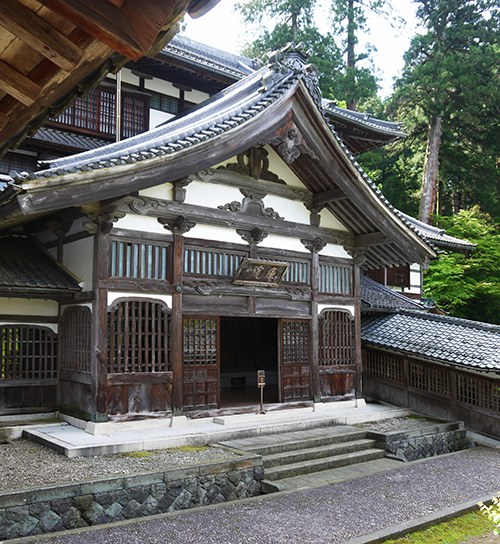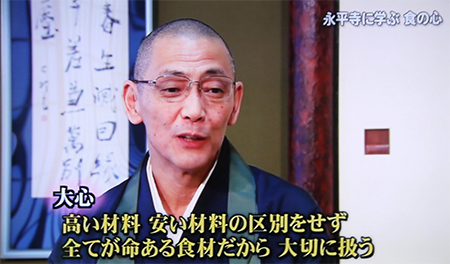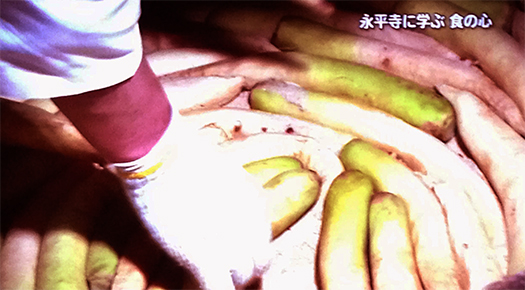


わたしが永平寺に、というか道元さんの禅宗に惹かれたのは、
かれが料理を宗教的な意味合いから非常に重視して
料理も修業であるという概念を吹き込んでくれたことが大きい。
わたしは男子が優勢な遺伝子の家系のものですが、
6人兄弟の末っ子として生まれたけれど、親からなんとなく
女の子を期待されていたことを幼心にずっと思い抱いていた。
なので、小学校3年の時にはじめて「家庭科」の授業で
サラダ作りを教えてもらったことがあって、深くうれしかった。
で、学校から帰ってすぐに自分でサラダを作ってみた。
そうしたら父母、姉から目を丸くして喜んでもらえた(笑)。
この良き体験がずっとこころに沈殿していって、料理大好き男子になった。
別に「すごい料理」というような関心ではなくごく普段の
日常食についての淡々とした繰り返しに「きょうはなにを作ろうかな」と
小さな楽しみを見出しているのであります。
そうなんです、3番目の動画からの写真での永平寺・典座の方の言葉が響く。
典座というのは曹洞宗の食事担当の役職者名。
「衆僧を供養す、故に典座あり」
〜修行者たちを供え養うために仏道で調理を司る「典座」の職がある〜
こういう考え方を仏教の大きな教えの中に取り込んできた
道元さんという思想に、強く親近感を抱かされるのです。
鎌倉以前の日本では僧が食事を作ることは重視されなかったが
「食事を作ることも僧の役割であり修行として行なわれるものだ」
この教えを伝えた。当時の僧侶の食事を系統立てて書いた記録を残している。
『典座教訓』
1237年成立。食事を作る人の心構えを記載。
「食事と向き合う」ことの重要性を説く。レシピは載っていない。
『赴粥飯法 』
1246年成立。食べる人の心構え、器や箸の扱い方などの作法まで細かく記載。
【基本ルール】
味付け 六味=五味+淡味
味付けの基本は〈苦・酸・甘・辛・醎〉の五味に「淡味」を加えた六味。
淡味とは、素材の持ち味を生かすために薄味にすること。

別に曹洞宗の教えを受けているワケではないのですが、
わたし自身の料理への感じ方、捉え方にごく近しいことが書かれている。
肉食を禁じた僧侶ではないので牛豚鳥と適材適所で使わせていただくけれど、
この永平寺・大庫院で教えられた精進料理の精神は納得。
10才に満たない少年期以来、ずっと作っている間に思い続けていたことが
実はこんなふうな考え方でまとめることができるのだと、
目を丸く、開かせられる思いがしてくる。う〜む、道元さんすごい。
<写真は永平寺「大庫院」外観と昭和5年当時で木造5階という建築模型>
English version
[Zen and food “cooking training” Eiheiji-10]
What attracted me to Eiheiji, or rather to Dogen-san’s Zen Buddhism, was
He attaches great importance to cooking from a religious point of view
He was greatly imbued with the concept that cooking is also training.
I’m from a genetic family where boys predominate,
I was born as the youngest of six siblings, but somehow from my parents
He always remembered in his childhood that he was expected to be a girl.
So, for the first time in the third grade of elementary school, in the “home economics” class
He was deeply happy to be taught how to make a salad.
So, immediately after returning from school, I tried to make my own salad.
Then his parents and sister made me happy with my eyes rounded (laughs).
This good experience settled down all the time, and he became a cooking-loving boy.
Apart from the interest of “great food”, it’s just normal
“What should I make today?”
We are finding a little fun.
That’s right, the words of Eiheiji and Tenzo in the photo from the third video echo.
Tenzo is the name of the person in charge of meals in the Soto sect.
“A memorial service for monks, therefore there is a ceremonial seat.”
-There is a job of “Tenzo” who manages cooking in Buddhism to offer and feed the practitioners-
I have incorporated this idea into the great teachings of Buddhism.
The idea of Dogen-san gives me a strong sense of intimacy.
In Japan before Kamakura, it was not important for monks to cook meals,
“Creating meals is also the role of the monk and is practiced.”
I conveyed this teaching. He keeps a systematic record of the monk’s diet at the time.
“Tenzo Lessons”
Established in 1237. Describe the attitude of the person who prepares the meal.
Explain the importance of “facing food”. The recipe is not listed.
“The porridge rice method”
Established in 1246. It describes in detail the attitude of the eater and how to handle the bowl and chopsticks.
【basic rule】
Seasoning Rokumi = Gomi + Light taste
The basic seasoning is Rokumi, which is made by adding “light taste” to the five tastes of <bitter, acid, sweet, spicy, and savory>.
Light taste is to make the taste lighter in order to make the best use of the characteristics of the ingredients.
I’m not the reason why I was taught by the Soto sect,
It is written that it is very close to my own way of thinking and understanding of cooking.
I’m not a monk who forbids eating meat, so I will use it with beef, pork and birds in the right place.
I am convinced of the spirit of vegetarian cuisine taught at Eiheiji Temple and Okoin.
What I’ve been thinking about while I’ve been making it since I was a boy under 10 years old
Actually, it can be summarized in this way of thinking,
I feel like I can open my eyes. Hmmm, Dogen-san is amazing.
Posted on 12月 7th, 2021 by 三木 奎吾
Filed under: おとこの料理&食, 住宅マーケティング, 日本社会・文化研究








コメントを投稿
「※誹謗中傷や、悪意のある書き込み、営利目的などのコメントを防ぐために、投稿された全てのコメントは一時的に保留されますのでご了承ください。」
You must be logged in to post a comment.